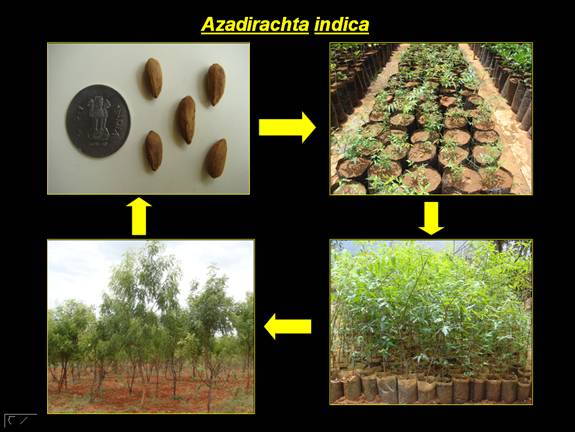
|
|
| Home | About Forestry | Eco-Tourism | Forestry Addresses | FAQs | Contact Us | |
|
| Minor Forest Products | |
Neem
Distribution: Neem grows throughout the greater part of India more especially in the drier parts of the country. It is a tree with wide climatic adaptability. In its range, the maximum temperature may exceed 40°C and the minimum temperature varies about 20°C to 15°C. The annual rainfall varies from about 450 mm to 1125 mm. Soil: It grows well on wide variety of soils ranging from sandy to clayey. It can thrive even in stony shallow soils or with calcareous soils. It grows best on well drained soils with subsoil water level fairly high. It can persist under adverse soil condition also. Flowering and fruiting: Leaf shedding and flowering are controlled by the climatic conditions. The trees become leafless for a short period. The new leaves appear in March-April. It flowers in April to May. The flowers are in panicles and are white in colour. The fruits appear soon after and attain full size in 2-3 months. A fully developed fruit is a smooth ellipsoidal drupe, greenish, yellow and normally one seeded. The fruits ripen generally in June - July. The yield per tree varies from 30-33 kg of seeds depending upon age and soil characteristics. Collection: Fruits fallen down or beaten down are swept together or hand picked. They Processing: Processing is done by decorticating and winnowing. Decorticator gives 70% Cultural practices: Nursery technique: Seeds are sown either directly or in polybags. The seeds do not require any pre-sowing treatment. As the seeds loose viability quickly the seeds should be sown as soon as possible. About 3300 seeds weigh one kilogram. Planting technique: One year old seedlings are preferable. Planting is done in July-August in pits dug up in April-May to allow weathering of the soil. The spacing may be 4 x 4 m and after 5 years, alternate trees are felled down. The recommendation is 8 - 10 m spacing. Yeild: After planting, the tree flowers at 6th or 7th year. After 10 year, each tree yields about 50 kg of fruits and 20 kg of seeds. Uses: The wood is used for small timber. Neem oil is used for the preparation of washing soaps and medicated soaps. The leaves are used as insecticides by exacting azadiractin. The bark, gum, leaves and flowers are all used in medicine. |
|
| Home | About Forestry | Eco-Tourism | Forestry Addresses | FAQs | Contact Us | |
|
| © All Rights Reserved. TNAU-2014. |
|
